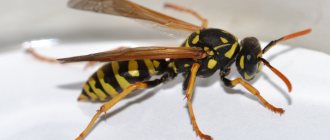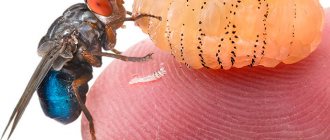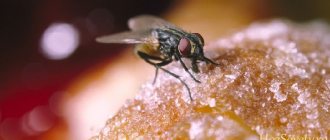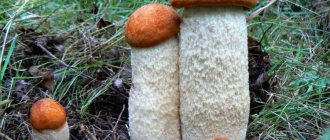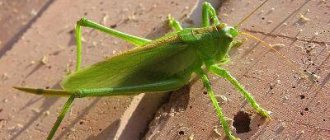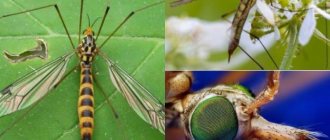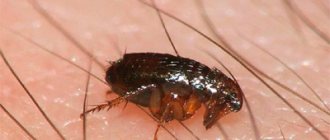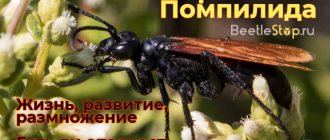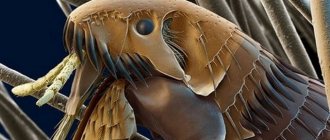- Wild animals
- >>
- Insects
The gadfly is a large parasitic fly, about which you can hear many incredible stories, in particular about their terrible bites and the larvae that they lay in the victim’s body. There are many misconceptions about the habits and lifestyle of these insects, and the main one is that these large flies suck blood. In fact, adult individuals are not blood-sucking - they do not feed at all during the entire period of their existence, but nevertheless they can cause much more harm.
Origin of the species and description
Photo: Gadfly
Botflies belong to the family of dipterous parasitic arthropod insects that are ecologically associated with human settlements, that is, they are synanthropic flies. They all lay their eggs in living flesh. At the moment, there are about 170 different types of gadflies, and some of them can harm human health and even cause his death. The oldest fossil remains of these flies were discovered in the United States in sediments over 50 million years old dating back to the Eocene era.
Video: Gadfly
The most dangerous types of gadflies:
- American cutaneous;
- equine or gastric;
- bovine subcutaneous gadfly;
- cavitary or nasopharyngeal botfly.
They all differ in the place of parasitism, the method of introducing their eggs into the body of a mammal, and the type of mouth opening. Each species prefers to use a specific animal to feed its offspring. The most dangerous for humans are considered to be the cavitary and gastric types.
Interesting fact: To become infected with these parasites, a person sometimes only needs to eat foods that have had botfly eggs on their surface. Inside the body, the larvae begin to develop very actively, feeding on their prey, and the person is deprived of vital energy. The migration of larvae throughout the body triggers pathological processes that can cause very serious health problems, and cases of human death are not uncommon.
The most dangerous types of nasopharyngeal gadfly
All female nasopharyngeal botflies are viviparous. They spray larvae into the nostrils (less commonly, the oral cavity) of animals. From there, the parasites move into the nasal sinuses, and then into the frontal cavity in the heads of livestock, feeding on its living tissues. Often the larvae are localized on the mucous membrane of the eye, making their way into its inner chamber.
In total, there are 35 species of nasopharyngeal botflies, divided into 9 genera. In the territory of the former Soviet Union, the greatest damage to livestock breeding comes from:
- The sheep gadfly (lat. Oestrus ovis) is the most famous and widespread representative of its subfamily. Its adult (imago) is an inconspicuous fly, the body of which reaches 1–1.2 cm. The color varies: from brown to gray-yellow. You can see black spots on the back. The entire body is covered with short hairs. This type of gadfly has small transparent wings, separated by brown veins and slightly spaced apart. The head is quite large and looks like half a ball. The eyes are dark, with a pronounced greenish tint, and sparkle in the light. As the name suggests, they prefer sheep to reproduce their larvae.
- Russian gadfly (lat. Rhinoestrus purpureus), often infecting horses. Externally, the adult is very similar to the adult gadfly, but the body has a brownish-purple color. The back has a red tint and is decorated with slightly shiny longitudinal stripes and numerous dark dots. The body is ovoid, colored purple-gray with a silver tone with a checkerboard pattern, and has no hairs. The transparent wings are decorated with 3 black dots located almost at the very base. They are a distinctive feature of Rhinoestrus purpureus from other gadflies.
- Cephenamyia trompe is a botfly that attacks reindeer. It is the causative agent of cephenomyosis, which is an inflammatory disease of the upper respiratory tract, often with purulent discharge.
- Cephalopina titilator squirts its larvae into the nostrils of camels. Provokes the development of cephalopinosis.
- The short gadfly (lat. Rhinoestrus latifrons) and the short-tailed gadfly (lat. Rhinoestrus usbekistanicus), like the Russian gadfly, parasitize the heads of horses, but are less common.
There are other types of nasopharyngeal gadflies, but those listed above are significant in agriculture. Parasites of this family that infect humans are found only in the tropics, although there are rare exceptions of attacks by the botfly on humans.
Appearance and features
Photo: What a gadfly looks like
Despite the large number of species of gadflies, they all have common features in the structure of their body and a similar appearance:
- their body length varies from 1.5 to 3 cm depending on the species;
- the oral apparatus is absent or reduced, and upon closer examination, cerciform jaws can be seen on the head;
- body with a lot of villi;
- large eyes with multi-colored iridescence;
- the body is round, quite wide;
- The gadfly has 6 legs, the front legs are slightly shorter than the hind ones;
- the wings with a large mesh are translucent, slightly longer than the body.
Depending on the species and habitat, the colors of parasitic flies may vary. Southern latitudes are characterized by the presence of orange-black stripes on a particularly shaggy body. In the north, these insects have a calm, rather nondescript color: dark gray, brown, various shades of blue. Very often, gadflies are confused with horse flies, but if you carefully study the appearance of these flies, then the differences between these insects are quite significant, moreover, the latter are blood-sucking.
Interesting fact: Gadflies can fly at speeds of up to 120 km per hour, which is comparable to the speed of a dragonfly.
The worm-shaped larva of the gadfly reaches a length of 2-3 cm. The dirty white body is divided into separate segments. It moves with the help of special growths-hooks.
Signs of infestation with gadfly larva
A female gadfly can lay eggs anywhere: on a person’s body, head, arms or legs. Before the larvae make their way inside the body, their presence can only be detected by chance. But when the parasite begins to be active inside, a person’s health worsens. Symptoms such as:
- weakness;
- dizziness;
- headache;
- nausea;
- temperature increase.
Fever
These are general signs. Otherwise, the symptoms depend on the location of the larvae:
- with subcutaneous myiasis - blisters appear on the skin, over time a hole forms in the center through which the larva breathes, suppuration may occur, and when the parasite moves, itching, burning, and pain are felt;
- with intestinal myiasis – abdominal pain, vomiting, diarrhea;
- in case of eye damage – redness, pain, lacrimation, decreased visual acuity;
- in the nosal form – copious mucus secretion, pain, frequent sneezing, swelling of the nose.
Without treatment, symptoms become increasingly worse.
Where does the gadfly live?
Photo: Insect gadfly
These parasitic flies are widespread throughout the world; they live on almost all continents except regions where it is very cold and there is a constant minus. They are quite thermophilic and reproduce quickly in southern latitudes - here they can be found in huge quantities. In Russia, some species are found even in the north of the country, the Urals, and Siberia. Specimens that are particularly dangerous to life and human health live only in hot, humid climates and are not found in our country.
Since they need large concentrations of mammals to reproduce, they settle near livestock farms and pastures. A large number of adult gadflies can be observed near rivers, swamps, and lakes. They love warmth, sun and moisture. Quite often, gadflies prowl through forests, fields and meadows, but they return to their usual place of residence and remain there all their lives.
Interesting fact: By parasitizing sheep and cows, gadflies cause great damage to livestock. If in the field of view of an adult there is not a sufficient number of objects in the body of which eggs can be laid, then the entire huge portion of larvae goes to one animal, which most often subsequently dies in agony. But even a few abdominal or subcutaneous parasites can cause serious disturbances in the functioning of animal organs.
How to protect yourself from the gadfly in the country
To make the area unattractive to insects, it is necessary to mow the weeds in a timely manner not only around the house and in the yard, but also behind the fence. Open, ventilated spaces are not to the liking of the parasite.
The gadfly reacts sensitively to odors associated with human or animal activity (feces, sweat). Therefore, it is better to arrange latrines and heaps of manure away from housing, and spray them with special preparations that eliminate odors.
You can protect yourself from the gadfly with ordinary sticky tapes - flycatchers, hanging them around the house, in gazebos. Special bags with bait for the destruction of horse flies and spiders are sold, which are laid out in places where insects are likely to accumulate.
If there are a large number of gadflies, horseflies, mosquitoes and ticks on the site, it makes sense to contact special treatment services. The territory is pollinated with special preparations that repel insects. Usually, one such procedure is enough for a season. But these methods cannot be called environmentally friendly, since strong toxic substances are used.
Folk methods of struggle
There are folk ways to scare away and fight gadflies. They are not as effective, but do not harm the environment, animals or beneficial insects.
Dried cloves are ground in a coffee grinder or mortar to a powder, poured with the simplest cologne and left for 10 days. For 1 teaspoon of clove powder, take 200–250 ml of cologne. Wipe the skin with the resulting product and spray clothes. The smell repels the gadfly.
You can prepare a soap solution using any mildly scented soap. They wipe the fur of pets with it, lubricate door frames, and spray the yard. The product is completely safe, but the gadfly does not like soap.
The smells of lemon, orange, and mint have a good deterrent effect. You can lay out orange or lemon peels on the plot and plant mint bushes. Another option is to purchase essential oils from these plants, dilute them with water and spray the area. Treatment will have to be carried out every 5-6 days, since the aromas quickly disappear.
When going for a walk in the forest to a pond, you should not forget about precautions. Clothing should be closed, treated with repellent (purchased or homemade)
You should definitely have a bottle of clean water, napkins or handkerchief and allergy pills with you.
What does a gadfly eat?
Photo: Gadfly
Adult individuals never feed, they do not even have a developed oral apparatus, and gadflies exist only due to previously accumulated reserves, which, while still a larva, “ate” inside the mammal’s body. During its short life, an adult gadfly loses about a third of its weight and dies due to severe exhaustion. In order to save energy and extend the period of their existence, in windy and cold weather females try to move as little as possible, remaining in secluded places among the grass and in the bark of trees.
The larvae grow inside the mammal using nutrients found in the tissues of its body. They can migrate around their host, choosing the most suitable and nutritious environment for themselves. Some species are found primarily in the intestinal tract and, when ripe, are excreted along with the animal's feces; others do not go as deep, being close to the surface of the skin.
Sometimes the larvae reach the brain of their host and even parasitize the eyeball, causing complete blindness. In the presence of parasites, the affected body rapidly loses nutrients, weight decreases, peculiar fistulas form on the surface of the skin, and the functioning of organs is disrupted.
Interesting fact: Cavity botflies are viviparous insects; they give birth to their larvae and literally splash them into the nostrils and eyes of the future host.
Now you know what happens when a gadfly bites. Let's find out how an insect survives in the wild.
Nutrition
The larvae feed on their hosts, while adult gadflies do not consume food at all. Their mouth is reduced. The body is nourished by substances that the gadfly intensively accumulates while in the larval stage.
That is why gadflies spend very little time as an adult insect - from 3 to 20 days, losing a significant part of their mass every day. If the weather is cold, gadflies try not to fly, conserving energy, in which case their life can last up to 30 days.
Features of character and lifestyle
Photo: Gadfly in nature
Gadflies are characterized by the formation of so-called “male harems,” when a huge number of males gather in dry lowlands. During the mating period, females themselves fly to them, and then immediately go in search of a suitable animal for laying eggs. Depending on the type of parasite, females behave differently when attacked: some make their way to the victim unnoticed by short flights and crawling, while others, on the contrary, circle above the herd, emitting a loud, characteristic sound.
Gadflies are distinguished by their importunity; they do not leave the animal alone for a long time until they reach their goal. Cows sense the approach of these flies and often gather in large groups, stopping drinking water and feeding. They behave very aggressively and, if there is a large body of water nearby, they tend to go into it up to their nostrils, but even in this case, gadflies have clearly developed tactics.
The beginning of the flight of gadflies and its duration directly depends on the zonal conditions of their development. It is much longer in the foothills, mountain areas, middle zone and shorter in the southern regions, on the northern border of their habitat. Depending on the ambient temperature, wind and precipitation, flight dates may shift by 2-3 weeks.
How are both insects similar to hornets?
The hornet is a large insect that is yellow and black in color. This insect looks like a wasp, only different in size. Hornets, gadflies and horseflies are similar in their large size and aggressiveness. They bite painfully. Their bites cause great discomfort and are dangerous.
After bites, the affected area swells, hurts, and itches. For people with allergies, this can be deadly, as the bites can cause anaphylactic shock. Hornets and gadflies settle anywhere - in the forest, in the city, on the plain and in the mountains.
Gadflies and horseflies are dangerous insects that are carriers of serious infectious diseases. Gadflies are parasitic in the body not only of animals, but also of humans.
When there is a mass accumulation of insects, it is important to use protective equipment - thick clothing, insecticides. If insects have besieged or even bitten, then you should carefully monitor the affected areas and, at the slightest complications or doubts, immediately consult a doctor
Social structure and reproduction
Photo: Insect gadfly
The gadfly goes through a full cycle of transformation: egg, larva, pupa, imago - adult. Life expectancy does not exceed one year, despite the fact that the imago exists from a week to one month, since it does not receive food from the outside at all. After fertilization of the eggs, the female strives to place them on the skin of the mammal as quickly as possible.
Some species of gadflies use mosquitoes to introduce their larvae into the animal’s body: to do this, they attach eggs to the legs of these bloodsucking mosquitoes and when the mosquito comes into contact with the surface of the victim’s body, the larvae hatch, penetrating inside through the puncture site. Cavity botflies can place their eggs on plants and food, which pets then eat.
The larvae continue their development in their intestines, and then emerge with the droppings as pupates. Flies can also attach their eggs in the area of the nostrils and lips of livestock, so that when the animals lick them, they swallow them. The female produces up to 700 eggs at a time, which she needs to quickly place in a safe, warm place. Most often, the gadfly clings them to the animal's fur, where larvae form inside the eggs under the influence of heat - only a fifth of the clutch survives.
The larvae then pass through the epidermis and invade the tissues:
- at the initial stage, the body length of the larva is 1.5-2.5 mm, but it actively feeds on the host’s blood and increases several times in a short period;
- at the second stage of its development, the grown and strengthened larva moves closer to the surface of the skin and releases two spiracles to obtain oxygen. At this time, large fistulas form on the body of animals;
- a protective capsule of connective tissue begins to form in the fistula, here the larva matures to the pupal stage and then emerges;
- the process of turning a pupa into an adult takes from 20 to 40 days.
There are many ways for these parasites to enter the body of a mammal. The process of the imago emerging from the pupae takes only a few seconds and almost immediately the fly that is born is able to fly and mate.
Symptoms and consequences of a gadfly bite
Only one species of gadfly, Dermatobia hominis, which lives in the forests of Central America, uses humans as a “reservoir” for rearing larvae. After a bite, a disease called dermatobiasis develops, manifested in local inflammation, suppuration and the development of general intoxication phenomena. A bite from a human gadfly is rarely fatal. One case of death of a one and a half year old child with multiple infestations, that is, with the penetration of a large number of larvae under the skin, was registered.
More often, the death of children is associated with brain damage when the larvae penetrate inside the skull. In this case, symptoms such as swelling of the upper body, inflammation of the lymph nodes, and headache associated with increased intracranial pressure are observed. Fortunately, such a complication develops extremely rarely after a Dermatobia hominis bite.
In Russia, people become victims of gadflies extremely rarely: such cases occur sporadically, since all species living in our country parasitize farm and wild animals. However, females still lay eggs under the skin of people, so it is important to know the symptoms of infection in order to consult a parasitologist or dermatologist in time.
The larva can appear on any part of the human body, but most often the eggs are laid on the legs, back or armpits. Very rarely, larvae are found in the eyes.
There are no symptoms of infection after a bite. It is almost impossible to feel that a female gadfly has landed on the skin due to the soft legs of the insect, covered with hairs. At the moment of the bite, a burning pain is felt, which quickly passes.
At the site where the eggs were implanted, you may notice a slight swelling, which is practically no different from a mosquito bite. After a few days, inflammation forms at the site of the swelling. It becomes painful, swells, an abscess forms, which after some time opens with the release of pus. This creates a hole through which the growing larva receives the oxygen it needs to breathe. Movement may be felt in the area of inflammation.
In addition to local manifestations, symptoms of general intoxication are noted:
- nausea and vomiting;
- feeling tired, increased fatigue;
- drowsiness;
- increased body temperature;
- pain in muscles and joints.
If the larva is in the eye area, when moving it will constantly irritate the mucous membrane, which will cause pain and discomfort. Intraocular pressure increases. Increased sensitivity to light appears, and lacrimation may occur. If the larva is not detected in time, it may end up in the vitreous body or in the anterior chamber of the eyeball, as a result of which the person may lose the organ of vision.
In rare cases, the larva may end up in the nasal cavity. In this case, the following symptoms are observed:
- headache;
- decreased sense of smell;
- swelling of the nasal mucosa, making breathing difficult.
If the larvae are detected in a timely manner, they are removed surgically. If removed quickly, infection does not pose a danger to the body. However, if you do not get rid of the larva in time, a secondary infection may develop, which can result in a life-threatening complication such as sepsis. Another complication of infection is an allergic reaction, which can vary in severity: from urticaria to anaphylactic shock.
If you suspect an infestation with gadfly larvae, you should consult a doctor. Under no circumstances should you remove the larva yourself. This is due to the fact that in many species the larva has numerous hooks for better fixation in the tissues, which can remain in the wound and cause suppuration.
Gadfly larvae are removed under local anesthesia. The doctor carefully grabs the larva with tweezers and pulls it out. After this, a bandage with an antiseptic is applied to the wound.
The following recommendations will help you avoid a gadfly bite:
- when going into nature, you should not wear bright clothes: they attract not only gadflies, but also blood-sucking insects, for example, horse flies;
- It is important that while walking outside the city, your arms and body are covered with clothes;
- in places where gadflies can be found (near farms, pastures, watering places), perfumes should not be used;
- It is advisable to cover the stroller with a special canopy;
- In nature, it is imperative to use repellents;
- Gadflies are attracted to the smells of feces and rotting. Therefore, toilets and cesspools should be installed as far as possible from the home or tourist stop;
- Gadflies are repelled by the smells of cloves, mint and citrus fruits: to prevent insects from entering the room, you can use aromatic oils.
Natural enemies of gadflies
Photo: Gadfly
Gadflies have very few natural enemies in nature due to the fact that the adult individual lives very little and prefers to hide in secluded, dark places. If females make flights, then males sometimes do not rise from the surface of the grass at all. Mainly only birds can hunt gadflies, both adults and their larvae, sometimes they are joined by ladybugs and mantises. Often these insects are used as biological weapons against gadflies.
Due to the enormous damage that these insects cause to livestock, there is a constant struggle against gadflies. Various chemical compositions are used to spray their habitual habitats; the skin of livestock is treated for preventive purposes - with timely treatment, animals can be protected from the penetration of larvae into the body. It has been noticed that during the active summer of these parasitic flies, livestock weight gain decreases by a third, and milk yield by 15 percent.
Interesting fact: Botflies prefer to live among dense vegetation where they can hide, so sometimes clearing the bushes and mowing the grass is enough to make them disappear from a certain area of land.
The dangerous human gadfly cannot survive in our weather conditions, but in the conditions of Central and South America it feels very comfortable.
The damage caused by gadflies
If we talk about animals, then first of all, parasites cause great harm due to the torment experienced by the carrier of the gadfly. Initially, the animal feels severe itching, then, when the larvae enter the organs and tissues, unbearable pain. This is especially true for animals whose larvae parasitize through the nasal cavity, entering the brain. Often in these cases the animal dies a painful death.
In place of the subcutaneous larvae, fistulas can form, and a lot of them. This significantly spoils the external qualities of the animal’s skin and makes it unusable. Such harm is felt by those who raise livestock for the purpose of selling their skins.
An animal whose body is affected by gadfly larvae produces less milk, loses weight, and its meat is of poor quality.
There are gadflies that bite humans. Although it is believed that this is mostly an accident. The gadfly can also lay larvae under human skin. As a result, large tumors and nodules appear on human skin.
Gadflies cause great harm
The most dangerous for humans is the white-headed gadfly. It flies into the open eyes of a person while he is awake. When an insect collides with an eye, the female sprays out eggs. The larvae instantly move under the eyelids, causing the person to feel a stinging pain. In this case, it is necessary to urgently take action, since there is a high probability of damage to the integument of the eyeball and socket. Sometimes it can even cause the eye to leak out.
This is why it is so important to know how to deal with these parasites.
Danger to humans and animals
The most dangerous species for humans are considered to be the cavitary and gastric botflies. After entering the host’s body, the larva begins intensive feeding. The victim loses vitality, there is a lack of vitamins in the body, and painful sensations arise. As a result of movement through organs, soft tissues, and meninges, health deteriorates. There are repeated cases of death from infection.
When the larva penetrates the body, a person develops a parasitic infection (myiasis). It progresses in several stages over time:
- The laying of eggs by the female gadfly in the hairline (mainly the head).
- When heat is transferred, the parasite emerges from the egg.
- It then penetrates the skin or organs.
- At this stage, a fistula is formed through which it exits the body.
There are groups of people who are more vulnerable to these flies than others. They should be more observant when interacting with cattle. These include:
- elderly people;
- diabetic patients;
- people who do not maintain proper hygiene;
- people with nervous disorders;
- having a penchant for alcohol;
- persons permanently located in tropical and subtropical zones.
For people involved in farming, the flight period of the gadfly causes colossal damage. The amount of milk in cattle noticeably decreases, it begins to get nervous and lose weight due to insufficient nutrition. In addition, the skin of such livestock will drop significantly in price.
